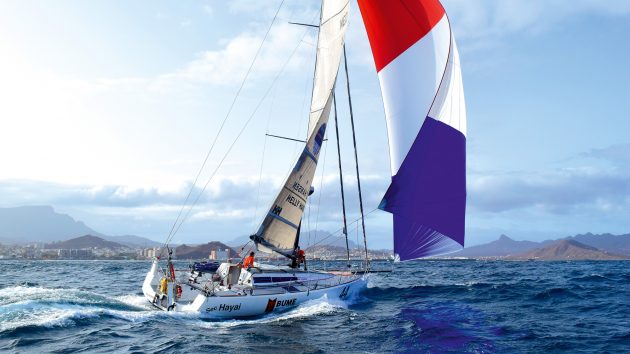Round the world racer Josh Hall explains to Andy Rice how to make the most of your autopilot for downwind sailing to make your boat faster and safer
Top-spec autopilots have become very sophisticated, not least in the use of AI (artificial intelligence), so much so that modern autopilot systems on an IMOCA 60 won’t leave you much change out of €500,000.
Fortunately many classes, such as the Class 40, don’t permit AI, and the autopilot remains an affordable extra crew member that doesn’t require food or sleep. Meanwhile the drive for ever-better reliability and reaction time demanded by the racing community has led to trickle-down improvements for pilots used in cruising applications.
Josh Hall has done enough solo miles to understand the good, the bad and the ugly of your typical mid-range autopilot system. Here Josh offers his five best tips on how to set up your boat for fast and safe downwind sailing, where you’re working in harmony with – not against – your precious autopilot.
Keep the centre of effort forward
The Class 40 boats are pretty much designed to be reaching and running machines in much the same way as the IMOCA boats. In strong downwind conditions we don’t sail these boats like traditional, heavier boats. They’re asymmetric with bowsprit, so you need to keep the true wind angle on a fairly hot setting to maximise the speed.
To keep the boat tracking downwind in a fast and safe mode, make sure the centre of effort of the sail plan is well in front of the mast. It’s better to have a well-reefed mainsail and have two headsails up because the boat will be much better behaved in a straight line as well as being easier to gybe. On a cruising boat it’s quite possible to have two headsails out and the mainsail down altogether. You reduce the risk of a broach enormously once you take the mainsail out of the equation.

For best performance an autopilot needs to be constantly monitored and adjusted. Photo: Paul Wyeth
Aim for high averages
Speed is your friend. The average ocean wave travels at 25 knots, so when you’re going fast and closer to wave speed you reduce the loads and make the boat safer and easier to handle. Set up your boat for high average speeds, don’t try and chase the peak speed at the expense of having any real slow moments. Trim the sail plan for good average speed and the autopilot will thank you for it.
Watch the tiller
Modern autopilots are very good at adapting to different wind and wave conditions. Even the non-AI systems have a good brain and a variety of settings that you can manipulate for different wind conditions. However, actually taking the helm and having a feel for what the pilot is dealing with is quite a good idea to get a sense of which way the loads are pulling on the tiller.
If you watch the tiller, it will tell its own story. If it’s oversteering, you can see it show up on the rudder reference screen, showing you how much rudder is on one way or the other. You can soon see if it’s working too hard, whether it’s got lee helm or weather helm, and adjust your sail plan accordingly.
TWA or compass heading?
Learn when to set the autopilot to true wind angle (TWA) or compass heading. Setting the autopilot to TWA can be useful in big waves, because as the boat accelerates down the face of a wave, the apparent wind screams forward yet the true wind angle remains the same. This means the autopilot is not going to put the boat into a massive bear away, which by the time the gust of wind has gone puts you on a gybe point (and then it’s trying to head back up and throw you into a broach).
But when sea conditions predominate – and particularly in confused seas – we sometimes need to put the autopilot on a compass course, which stabilises the steering. Then you need to watch the wind direction and actively trim the boat around the constant compass heading, whereas if you’re on a TWA you can let the boat go more, while accepting that you’re going to do more of a snaky course.
If it’s a very stable wind then having it on a compass heading is a good option. So depending on the wind and sea conditions you choose your mode. You want the autopilot to be making small adjustments all the time, not making big changes retrospectively.
Don’t skimp
For a high performance autopilot for something like a Class 40, there are only really two options I’d consider; NKE or B&G. In terms of how they perform I don’t think there’s a lot to choose between the two, but what B&G do have is global support, while NKE is a bit more French-centric. As for the actual ram that controls the tiller, Raymarine is pretty much the industry standard these days.
 If you enjoyed this….
If you enjoyed this….
Yachting World is the world’s leading magazine for bluewater cruisers and offshore sailors. Every month we have inspirational adventures and practical features to help you realise your sailing dreams.Build your knowledge with a subscription delivered to your door. See our latest offers and save at least 30% off the cover price.






